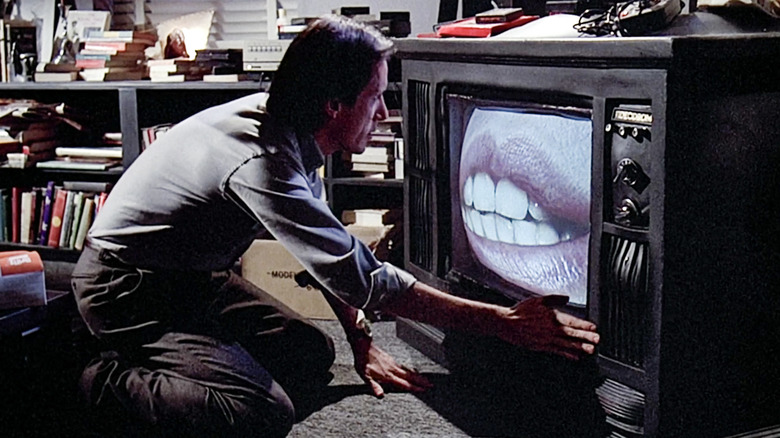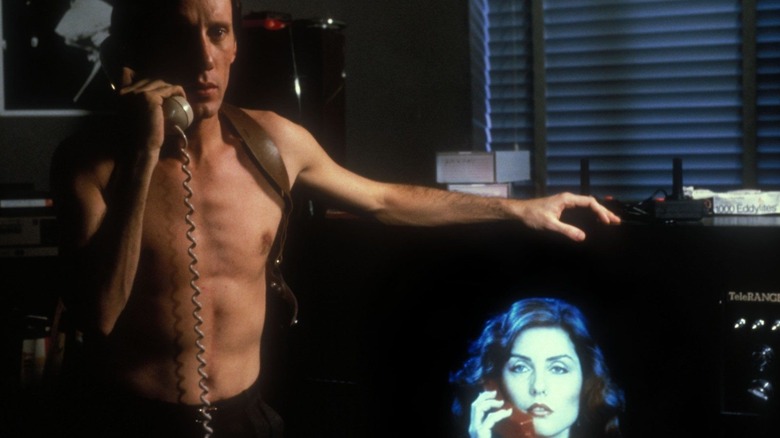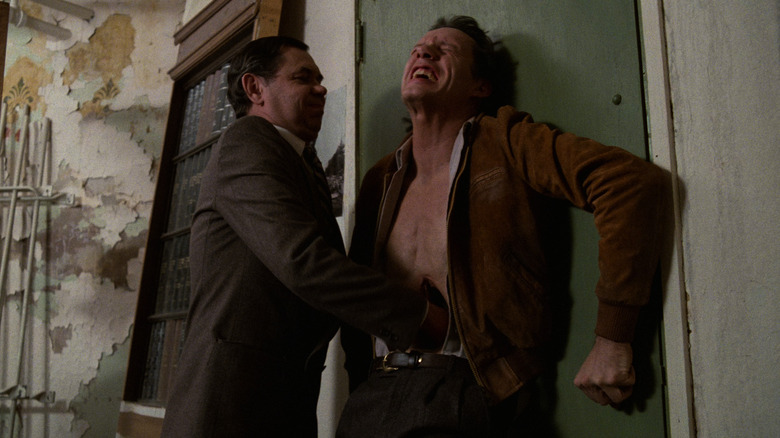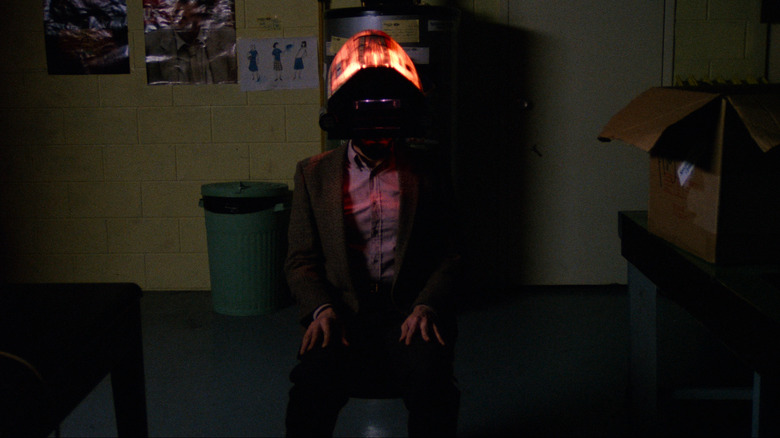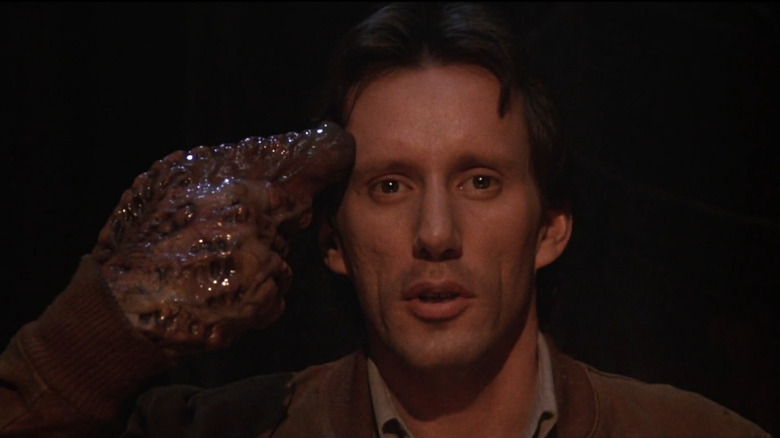Videodrome's Most Confusing Moments Explained
Acclaimed filmmaker David Cronenberg's 1983 film "Videodrome" stars his frequent collaborator James Woods as Max Renn, the owner of a Canadian video channel that plays the raunchiest content Max can find, offering viewers things that they can't find on major networks. In his search for new material, Max stumbles across Videodrome, a shockingly violent program of sadomasochistic torture.
Max can't help but develop an obsession with the program — as does his thrill-seeking lover, the advice hotline radio host Nicki Brand. He inquires about Videodrome and is directed to the office of Professor O'Blivion at the Cathode Ray Mission, a place that offers people free access to television in confessional-like cubicles. Inside he meets the professor's daughter, Bianca O'Blivion, who offers to send him a taped message from her father.
In his tape, the professor explains that he helped develop Videodrome, but it caused him to develop a brain tumor. O'Blivion is killed in the tape by a masked figure who reveals herself to be Nicki. The walls of the television become flesh, and he makes out with her through the screen. When he visits Bianca again, she explains that O'Blivion's partners decided to kill him and use the Videodrome technology for evil and that Max had already been infected by it.
After inserting a gun into a cavity in his chest, Max goes to Videodrome voluntarily and allows them to put him in an immersive headset, where he has more visions of Nicki. Upon waking, he discovers that his right-hand man Harlan has been working for Videodrome the whole time to hand them control of his channel.
What is Videodrome about and how does it end?
Max soon learns that the goal of Videodrome is population control — to give deadly brain tumors and mind-altering hallucinations to those who seek out sexual or violent imagery. Barry Convex, Max's point of contact at Videodrome, puts a videotape inside Max's chest cavity and programs him to kill his partners and give them control of his channel. Max's arm fuses with his gun and he assassinates his partners.
When Max attempts to shoot Bianca O'Blivion on Convex's telepathic orders, she shows him a video of Nicki being killed by Videodrome and explains that her image had been used to seduce Max to their cause posthumously. The TV shoots him, and the bullets exorcise the tape that Convex put inside him and inject him with the philosophy of the Cathode Ray Mission. These bullets make Max "the video word made flesh," as Bianca puts it. He then turns on Videodrome, turning Harlan's arm into a bomb and assassinating Convex in plain sight. Max's bullets infuse the dead villain with the video word made flesh, which is embodied by the fleshy substance that comes pouring out of his many bullet wounds.
In the end, our anti-hero retreats to an isolated hideout where Nicki reaches him through the TV, explaining that he has to move on to the "next phase" if he really wants to hurt Videodrome. Max sees himself shooting himself in the head and saying "Long Live the New Flesh" onscreen, and so he does exactly that.
What is the meaning behind Videodrome?
"Videodrome" struggles with one of the biggest questions that has faced the last few generations of parents and children alike: Is violent and sexual imagery sought after because it exorcises our darker impulses through a harmless channel, or is it teaching us these impulses through the violent imagery and encouraging us to act on them in real life? The lesson that the fictional program Videodrome instills is that those who seek out this media are taught by it, and so their state of mind and physical body are altered by Videodrome. The program punishes the viewer for seeking this imagery out and condemns them to death, but it raises an interesting moral conundrum. If Max hadn't been searching for something violent and shocking, would Videodrome have had the power to kill him or to make him kill? If he hadn't stuck a gun inside of himself in the first place, could he have been used as a vessel for violence?
The Cathode Ray Mission takes a vastly different approach to the same problem and instead reaches out to individuals on the fringes of civilization — those most likely to seek out the seedy content that Max and Videodrome program — and reincorporate them into polite society by immersing them in more typical television. It's not clear whether their method is effective, and it is definitely eerie to see in practice, but it is certainly less cruel than Videodrome's eugenic approach.
The important thing is, whether the impetus of Max's pursuit of Videodrome is to be shocked, to be turned on, or to find the hidden truth behind this sinister power, it all ends the same way. Peeling back the layers of the conspiracy only further embroils him in it, until the only way to escape is to die. Once he opens Pandora's box, there is no going back.
Which parts of Videodrome were real?
So, which of Max's hallucinations were real, and which were fake? Well, it's possible that everything that Max experienced was a delusion, but there are several things that seem to be definitively real and others that almost certainly took place inside the protagonist's head. However, not all of the surreal moments are firmly hallucinatory.
One of the first inexplicable moments in the film — although not necessarily a surreal one — is when the supposedly deceased Professor O'Blivion addresses Max by name. How did he know his name if he was already dead when his daughter gave Max the tape? Well, the tape seems to have been infused with the Videodrome program, which bends the viewer's reality and fuses it with the television. So, while it's possible that O'Blivion foretold Max's involvement in the conspiracy, it's more likely that Max imagined himself being addressed.
Of course, the film takes a sharp turn later in this same scene, when Max makes out with the television. The seedy programmer is completely seduced by the sexuality of television. It's an important metaphorical moment and it is meant to read as a hallucination, but the line between illusion and reality gets more blurred from there on out.
When Max sticks a gun into his chest cavity, seemingly out of perverse curiosity, he casually chooses violence. Whether or not it was a figment of Max's imagination, this scene represents that his proclivity towards darkness is allowing violent programs like Videodrome to control him and force him to murder his partners. The double assassination appears on television news, seemingly unbeknownst to Max, which suggests that it was real and not a hallucination. However, the gun being fused to his arm could have been his imagination.
The ending of Videodrome explained
The corruptive depiction of Max's programming through the insertion of videotapes into his flesh, or the shooting of bullets through a fleshy television screen, could simply be a symbolic depiction of his reaction to imagery on a screen. Or perhaps this is how Max's tumor-ridden mind has visualized the impact of these programs on his psyche. Of course, it also remains possible that the surreal body horror aspects of "Videodrome" are actually part of the universe of the film and don't just exist inside the visions of the protagonist.
When it comes to the gun infused with his arm or his interaction with the television sets, whether delusion or not, the machine becomes an extension of his flesh, and yet it controls him. This echoes what Professor O'Blivion says about the cathode ray being an extension of the human eye that commands its attention and influences the brain behind it.
The ending of "Videodrome" is one of the most confusing moments of the film. At first, we want to believe that the O'Blivions are righteous and that Max can be redeemed by them. However, once under their control, he only fights fire with fire, combating the violence of "Videodrome" by murdering two more people. Both of these programs sought to make him destroy others, and the only way his war path would end was in self-destruction. Max had completely succumbed to his delusions, and they killed him. Suddenly, whether these visions were caused by Videodrome or not doesn't seem to matter. Either way, the message remains the same: that Max and the television had a toxic relationship, regardless of who between them was more to blame.
